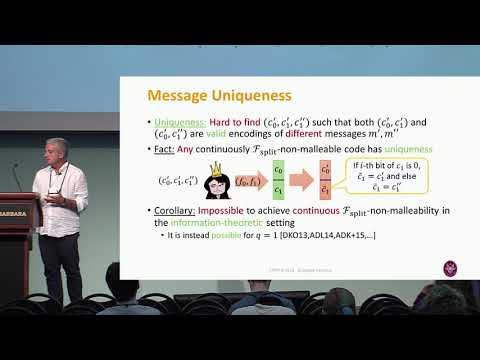Welcome to the resource topic for 2018/542
Title:
Continuously Non-Malleable Codes in the Split-State Model from Minimal Assumptions
Authors: Rafail Ostrovsky, Giuseppe Persiano, Daniele Venturi, Ivan Visconti
Abstract:At ICS 2010, Dziembowski, Pietrzak and Wichs introduced the notion of non-malleable codes, a weaker form of error-correcting codes guaranteeing that the decoding of a tampered codeword either corresponds to the original message or to an unrelated value. The last few years established non-malleable codes as one of the recently invented cryptographic primitives with the highest impact and potential, with very challenging open problems and applications. In this work, we focus on so-called continuously non-malleable codes in the split-state model, as proposed by Faust et al. (TCC 2014), where a codeword is made of two shares and an adaptive adversary makes a polynomial number of attempts in order to tamper the target codeword, where each attempt is allowed to modify the two shares independently (yet arbitrarily). Achieving continuous non-malleability in the split-state model has been so far very hard. Indeed, the only known constructions require strong setup assumptions (i.e., the existence of a common reference string) and strong complexity-theoretic assumptions (i.e., the existence of non-interactive zero-knowledge proofs and collision-resistant hash functions). As our main result, we construct a continuously non-malleable code in the split-state model without setup assumptions, requiring only one-to-one one-way functions (i.e., essentially optimal computational assumptions). Our result introduces several new ideas that make progress towards understanding continuous non-malleability, and shows interesting connections with protocol-design and proof-approach techniques used in other contexts (e.g., look-ahead simulation in zero-knowledge proofs, non-malleable commitments, and leakage resilience).
ePrint: https://eprint.iacr.org/2018/542
Talk: https://www.youtube.com/watch?v=UDMc-YthegU
See all topics related to this paper.
Feel free to post resources that are related to this paper below.
Example resources include: implementations, explanation materials, talks, slides, links to previous discussions on other websites.
For more information, see the rules for Resource Topics .
